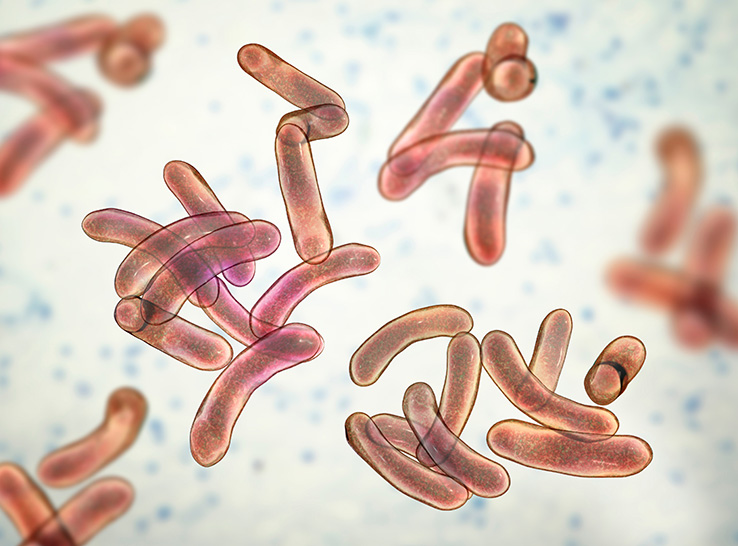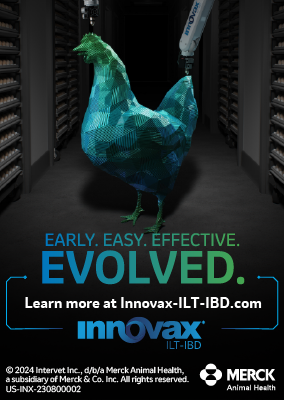 Fowl cholera is a bacterial disease of poultry that commonly affects chickens around 15 weeks of age and older, but it can impact birds as young as 6 weeks, cautions Charlie Broussard, DVM, Merck Animal Health.
Fowl cholera is a bacterial disease of poultry that commonly affects chickens around 15 weeks of age and older, but it can impact birds as young as 6 weeks, cautions Charlie Broussard, DVM, Merck Animal Health.
Caused by Pasteurella multocida, acute cases of the disease result in sudden death and high overall mortality; chronic cases produce low-grade mortality, lameness and reduced production.
“Because fowl cholera affects birds in the early weeks of life, and the associated losses and costs can run high, prevention through management and vaccination is the recommended strategy,” Broussard says.
Although there are 16 fowl cholera serotypes identified, types 1 and 3 are most common in chickens, while types 3 and 4 are found in turkeys.
“It’s important to select the appropriate vaccine strain for the field challenge,” Broussard adds. “Of course, proper vaccine administration and technique, as well as monitoring ‘takes’ are all steps needed to achieve adequate protection.”
Start with management
Bird management and husbandry are the first lines of defense for many diseases, but that’s particularly true for fowl cholera because it can spread in many ways throughout the environment. Here are some places to start:
- Biosecurity: multocida is susceptible to ordinary disinfectants, sunlight, drying and heat. So, cleaning between bird groups is important, especially if there’s been a previous challenge.
- Mortality removal: Look for and remove dead birds at least daily. multocida can spread from dead birds to live ones via pecking.
- Water sanitation: The bacteria are easily found in drinking water, so establish an ongoing water-sanitation program. Use a high-pressure flush followed by a cleaner/sanitizer, but consult with your veterinarian to select the correct one.
- Varmint control: Rodents, wild birds, pets and other animals may carry multocidaand contaminate the feed, water and environment. Take actions to keep them out of poultry houses.
Establish the right vaccination program for fowl cholera prevention
The next step in fowl cholera prevention is to establish a thorough vaccination program. Broussard says there are two general types of vaccines — live and inactivated. For broiler breeders, there are two live-cholera vaccines available, both of which contain attenuated serotype 3×4 strains and can cross-protect against all serotypes.
Live vaccines are administered via the wing-web method, after which live P. multocida multiply in the bird to stimulate the immune system.
“A fully immunized bird will be protected against most fowl cholera field challenges,” Broussard says. “However, it’s important to note that attenuated vaccines will not spread bird-to-bird, so it’s critical to ensure all birds are vaccinated; otherwise unvaccinated birds will remain susceptible to cholera.”
He notes that all live fowl cholera vaccines can produce some post-vaccination reactivity which can cause lameness and low-grade cholera in susceptible birds. Males are considered most susceptible due to their restrictive feeding programs.
“Males typically receive the mildest vaccine to minimize reactions,” he adds. That would be the M-9 strain vaccine; the PM-1 strain vaccines are used for intermediate fowl cholera challenges.
Inactivated vaccines (bacterins) or “killed” vaccines are serotype-specific. “If the cholera challenges in the field are caused by a different serotype, the killed vaccine will not prevent the disease,” Broussard explains. So, that will require some sequencing. The advantage of using a bacterin is the vaccine cannot cause disease.
Vaccination technique is critical
The live fowl cholera vaccine is fragile, negatively impacted by application errors and relies on the abilities of the vaccination crew.
“The crews often see their job as piecework,” Broussard says. “If they’re not taught that their work is critical to flock performance, they may not worry about missing a bird or two. They need to understand that a missed bird has a very good chance of becoming a dead bird.”
Vaccination crews also need feedback from “takes” monitoring to measure their performance.
Broussard offers these tips to ensure fowl cholera vaccination success:
- Protective immunity requires two live vaccinations given 6 to 8 weeks apart.
- The first vaccination should occur between 10 to 12 weeks of age. The potential for lameness, low-grade mortality and cholera increases if the first vaccination is later than 12 weeks, especially in male birds.
- The second vaccination typically occurs at 18 to 20 weeks in association with bird handling.
- Do not administer antibiotics effective against fowl cholera for 5 days before or 7 days after vaccination. Medication may be administered if needed once the birds have developed vaccination “takes.”
For more information on managing fowl cholera, click here.
Editor’s note: Content on Modern Poultry’s Industry Insights pages is provided and/or commissioned by our sponsors, who assume full responsibility for its accuracy and compliance.









